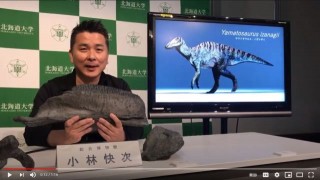Loading
Search
▼ New Dinosaur Fossil Discovered On Awaji Island, Named After Japanese God
- Category:Other
Well, new to us at least.
Being the relatively small country it is, Japan doesn’t come across dinosaur fossils as easily as other places like neighboring China, so it’s always a special treat when one is unearthed.
Fukui Prefecture is one place where dino remnants were found, and as a result they went all out decorating one of their stations in full Jurassic fare and established a leading museum in paleontology.
At about the same time, back in May of 2004, an amateur fossil hunter named Shingo Kishimoto came across an interesting specimen in Sumoto City on Awaji Island, part of Hyogo Prefecture. The fossil was in a layer of rock that dated back to the late Cretaceous period, some 72 million years ago.
This find caused the nearby Museum of Nature and Human Activities to launch a full survey of the area, which eventually turned up a further 22 fossils.
They were all turned over to noted paleontologist Professor Yoshitsugu Kobayashi of The Hokkaido University Museum who, after careful analysis, determined the fossils to be the jaw of a new species of Hadrosauridae.
Hadrosauride were a family of herbivorous dinosaurs known for a duck-bill-like shape in their snouts. That family of dinosaurs was said to thrive during the late Cretaceous period, and this new species is believed to have evolved from it based on the unique arrangement of these jaw bone fragments.
With all the parties involved in this discovery, the big question was who would become this newly discovered species’ eponym. Kishimototops and Kobayashidon certainly had a ring to them, and even though it doesn’t roll of the tongue, Museumofnatureandhumanacivitiesaurus couldn’t be ruled out completely.
In the end, it would seem a compromise was struck and the long-extinct beast’s name became Yamatosaurus izanagii.
▼ Prof. Kobayashi announcing the dino’s new name,
which you can see in the upper right.
https://youtu.be/BFHz_LB6tCI
“Yamato” is the name of the the ancient center of Japan, and by extension eventually referred to the entire country itself.
“Izanagi” is the name of one of the creation gods in ancient Japanese mythology. He and his sister-wife Izanami gave birth to all the islands of Japan with none other than Awaji Island the first – the first one they didn’t cast away for being imperfect at least.
So the name of this dinosaur is linked to the very origins of the country. It’s a poetic appellation that ties together the very long history and prehistory of Japan.
Kishimoto said of the name, “I am grateful that it was given a name that identifies it as a Japanese dinosaur from Awaji. I want many people to know about it.”
Yamatosaurus izanagii was believed to have weighed between four and six tons and measured about 7.5 meters (25 feet) long. Prof. Kobayashi believes the location of the fossils in a costal area may help shed light on the effects that environment has on evolution in the species.
All of the fossils will be on display at the Museum of Nature and Human Activities from 12 May for those who would like a peek at these pieces of history.
Personally, I’m going to hold out until the inevitable creation of a Yamatosaurus izanagii yurukyara mascot so I can see that too, and kill two dinosaurs with one stone.
- May 3, 2021
- Comment (0)
- Trackback(0)


